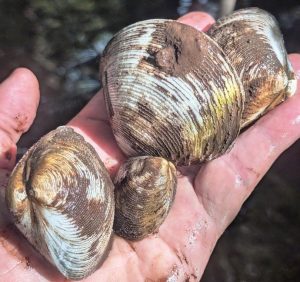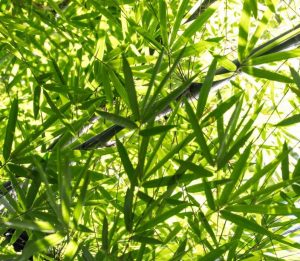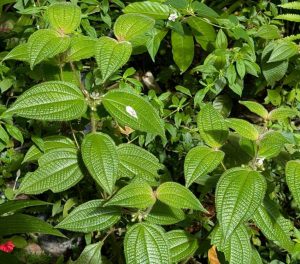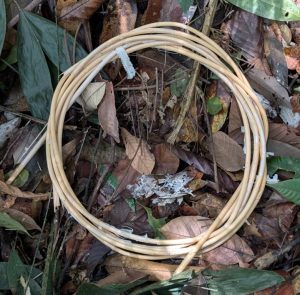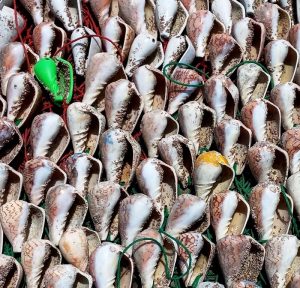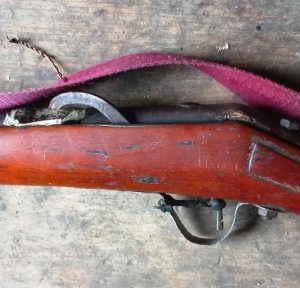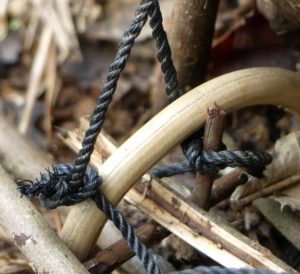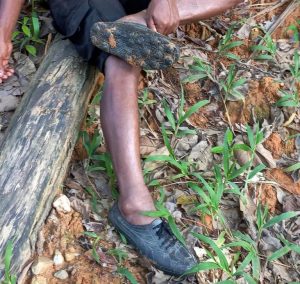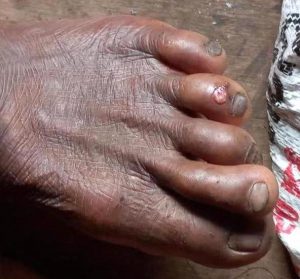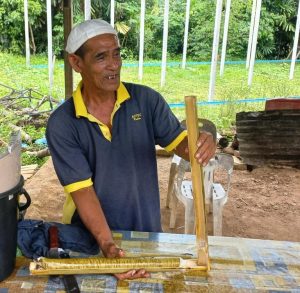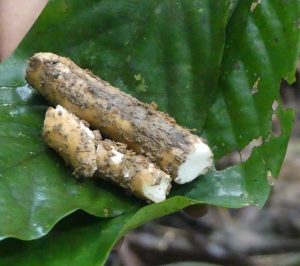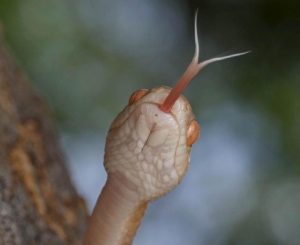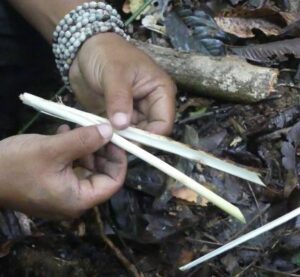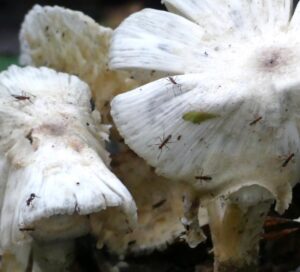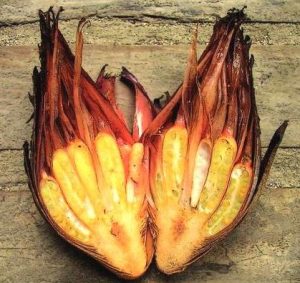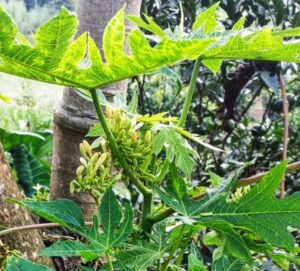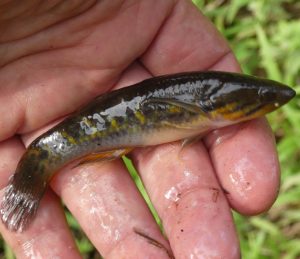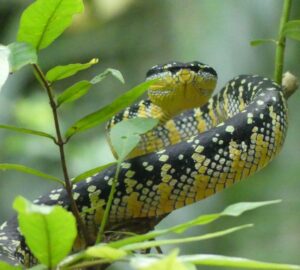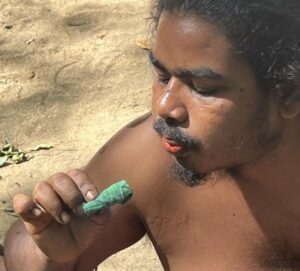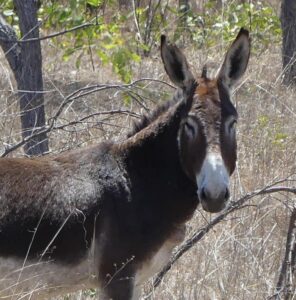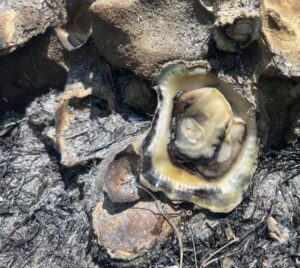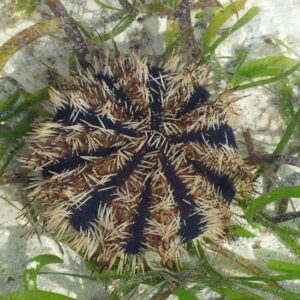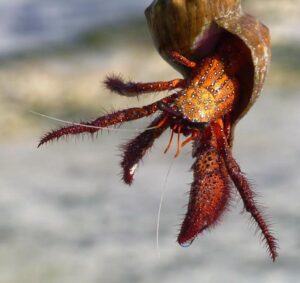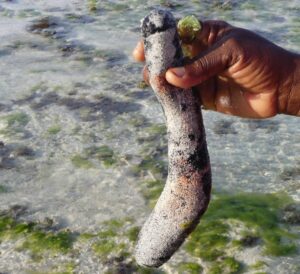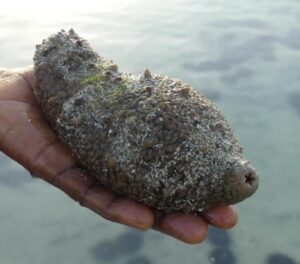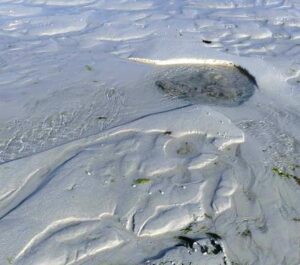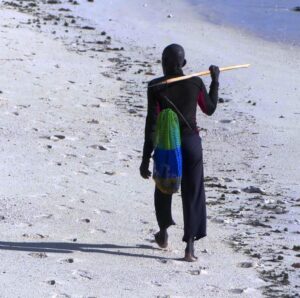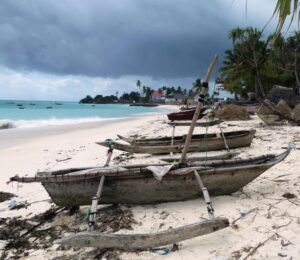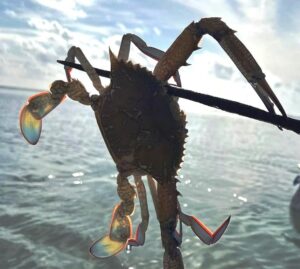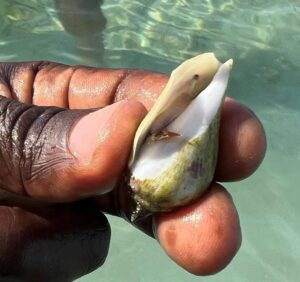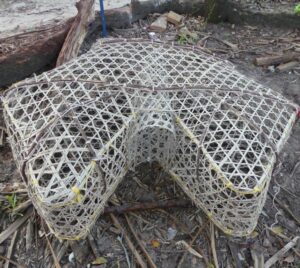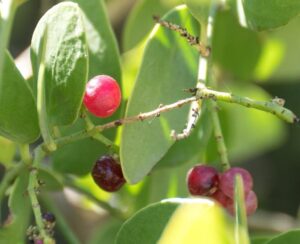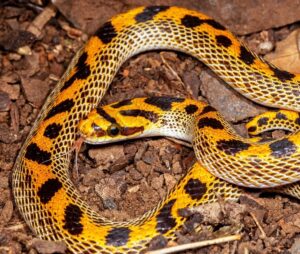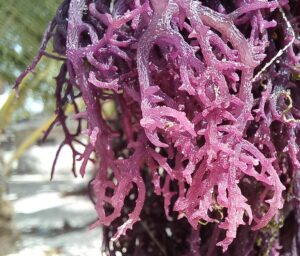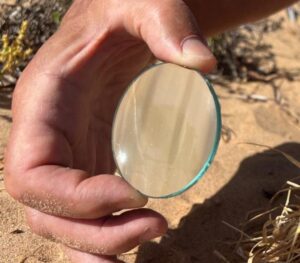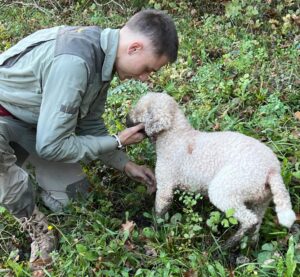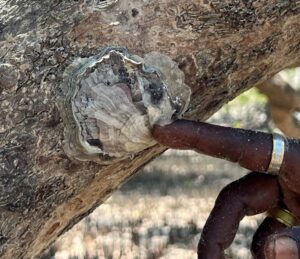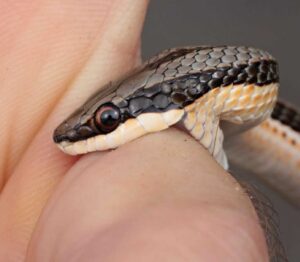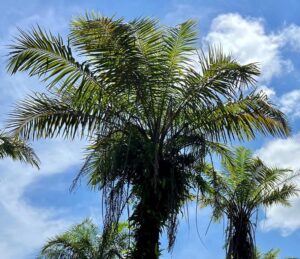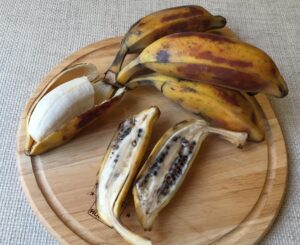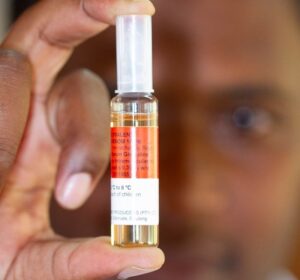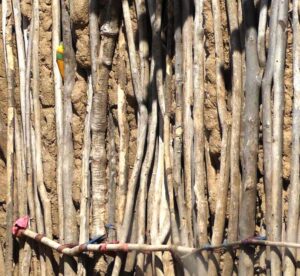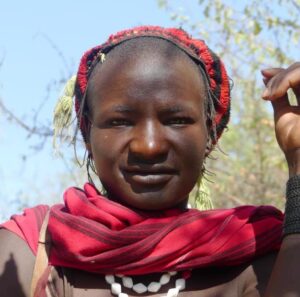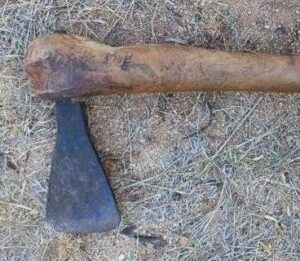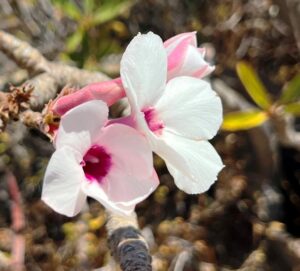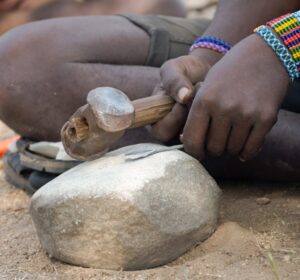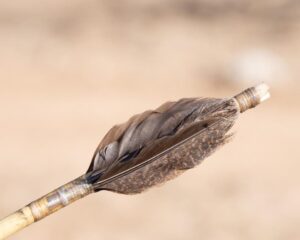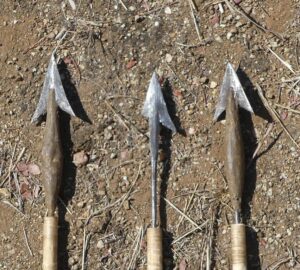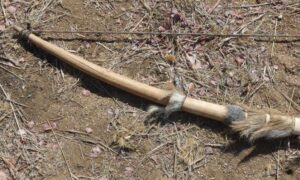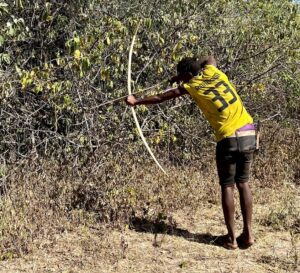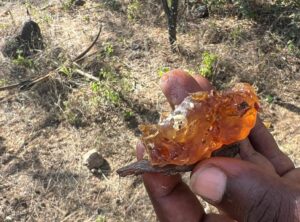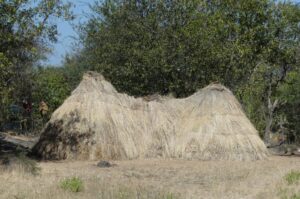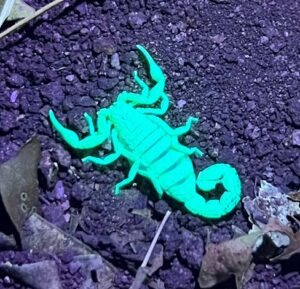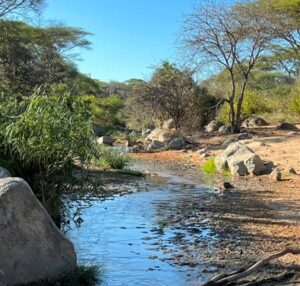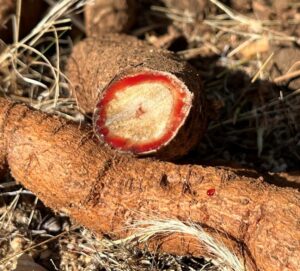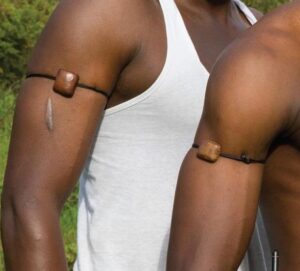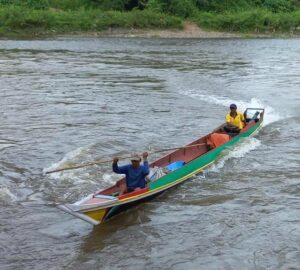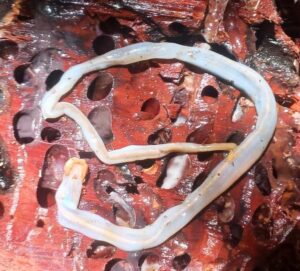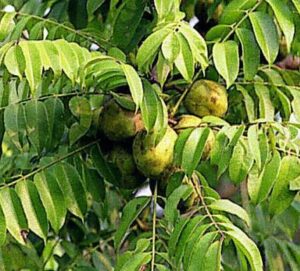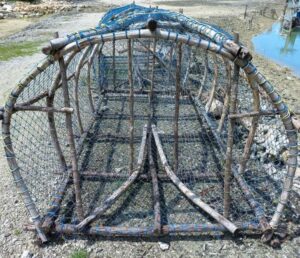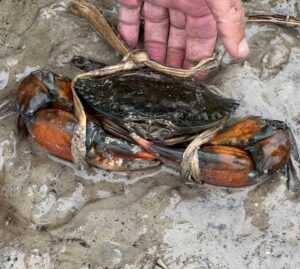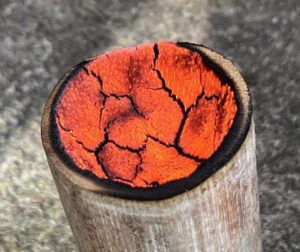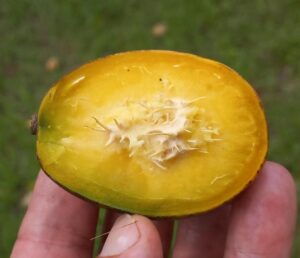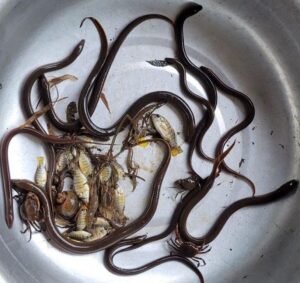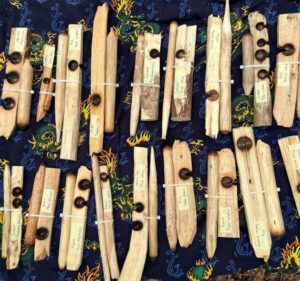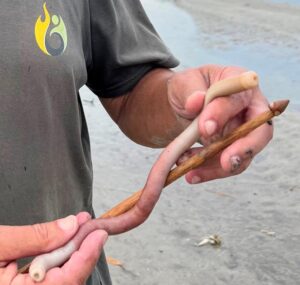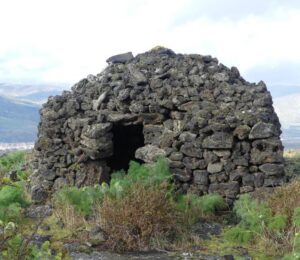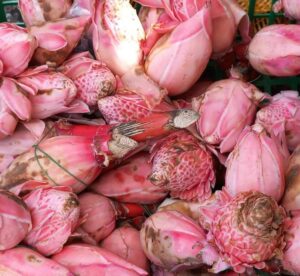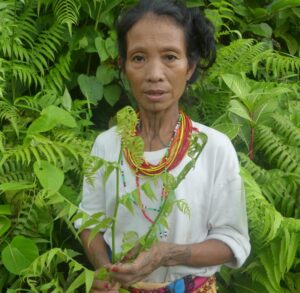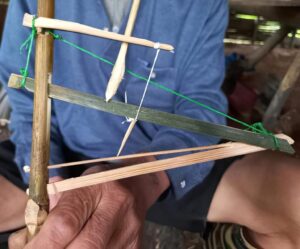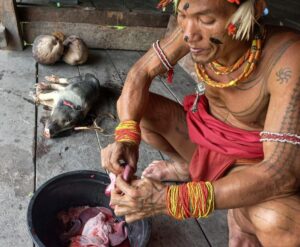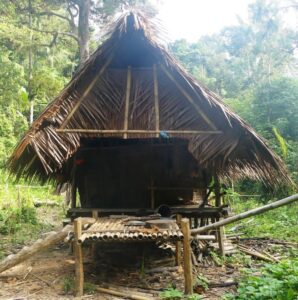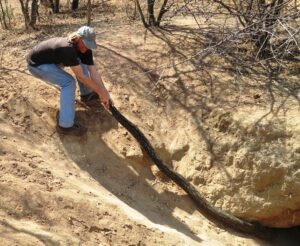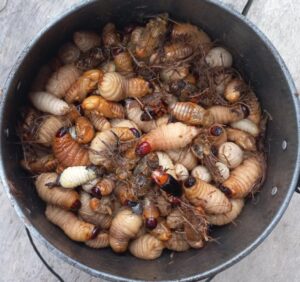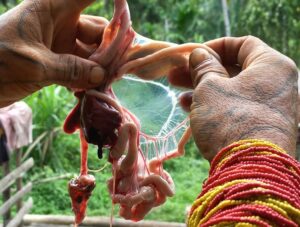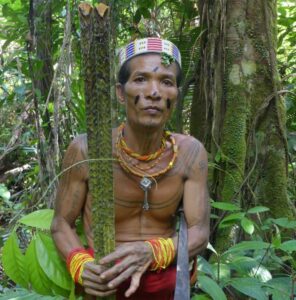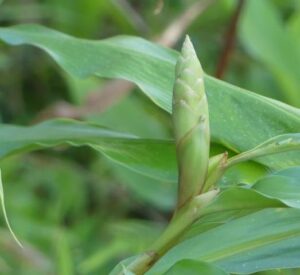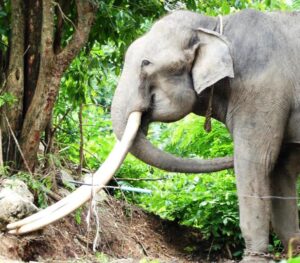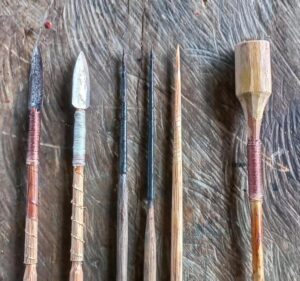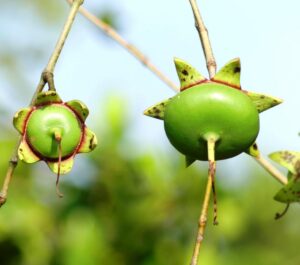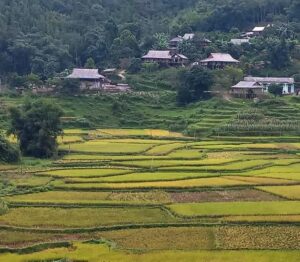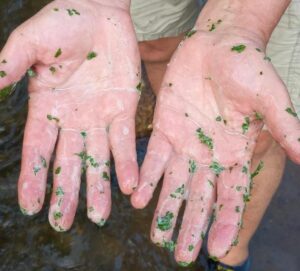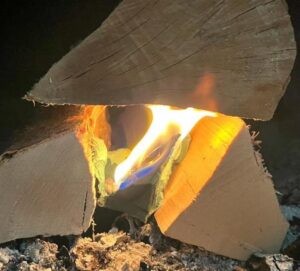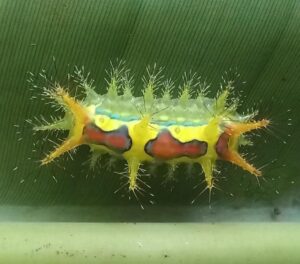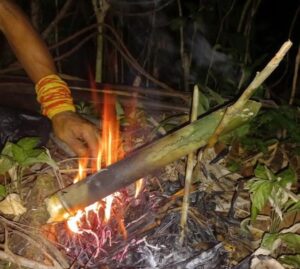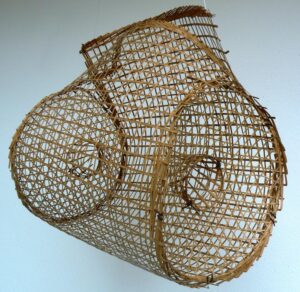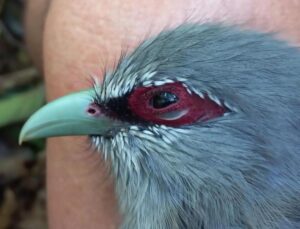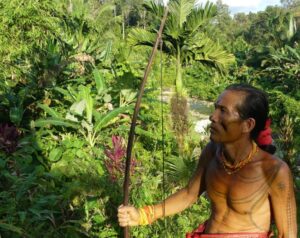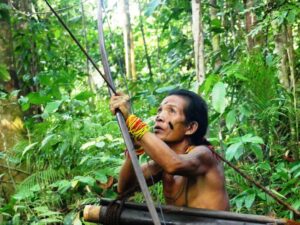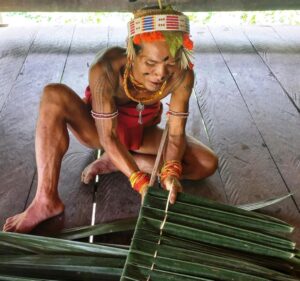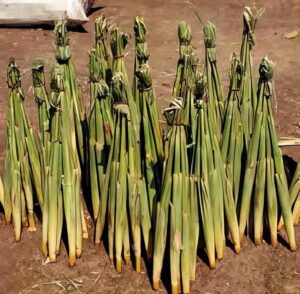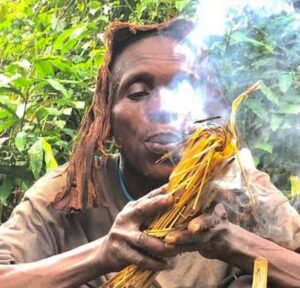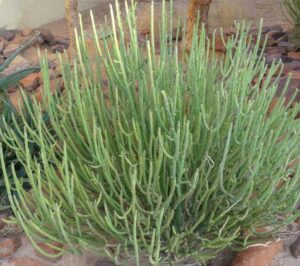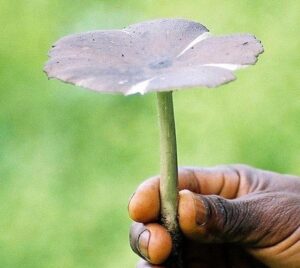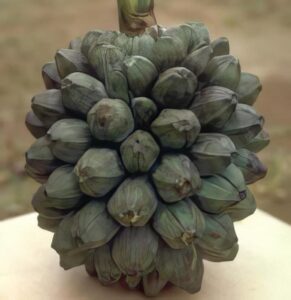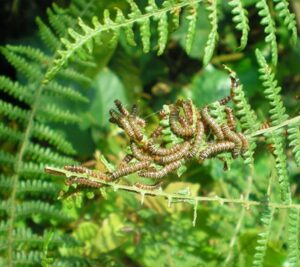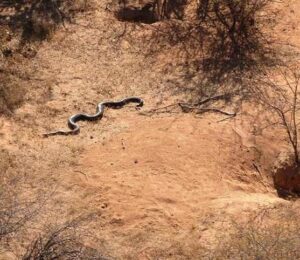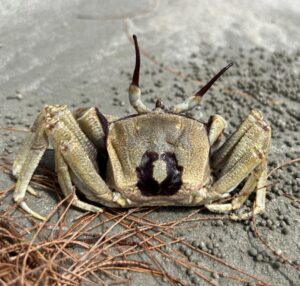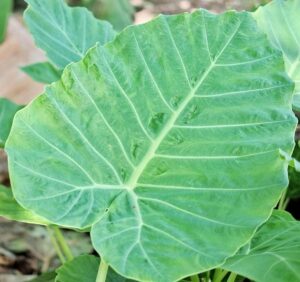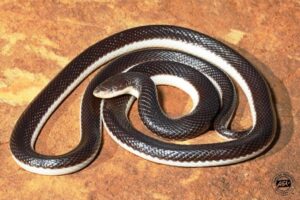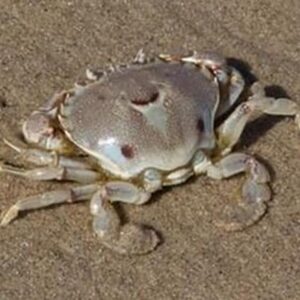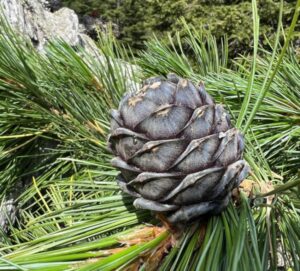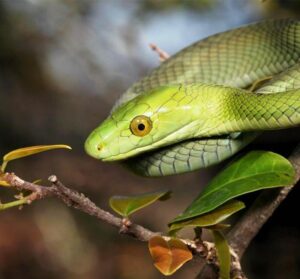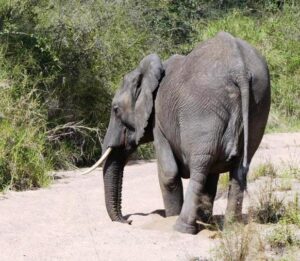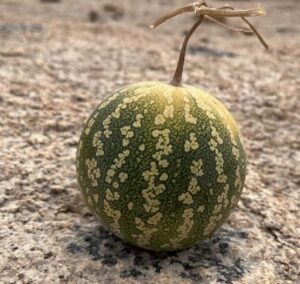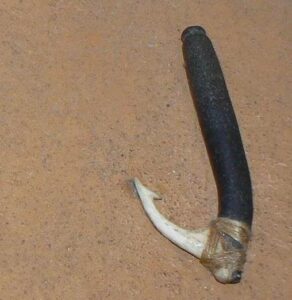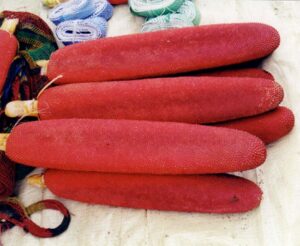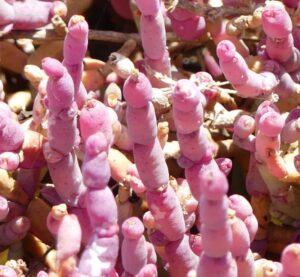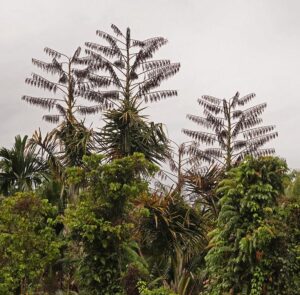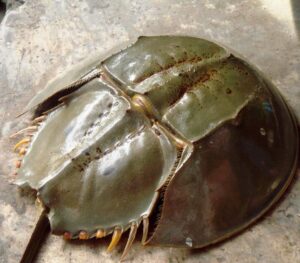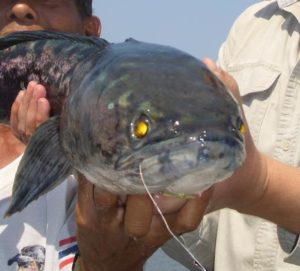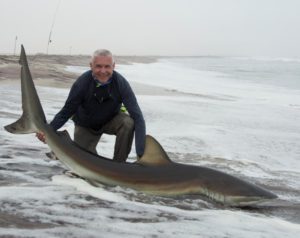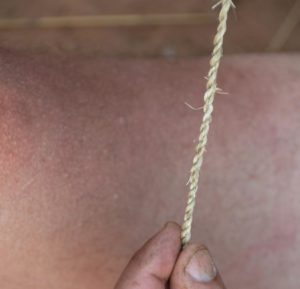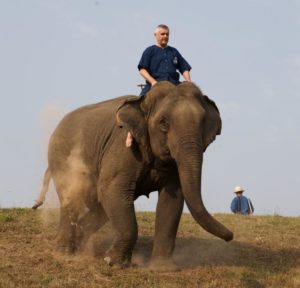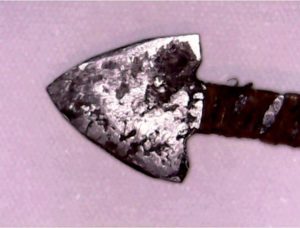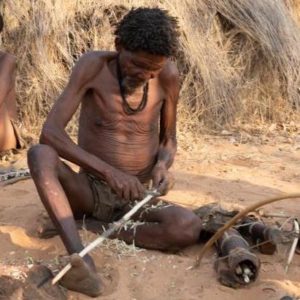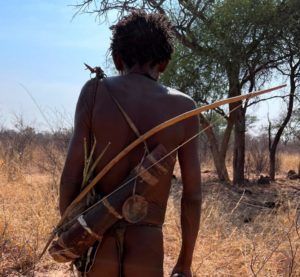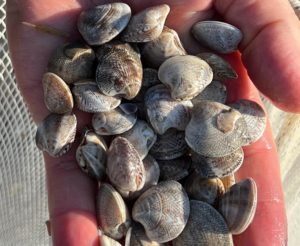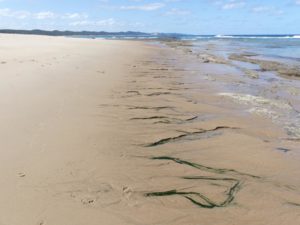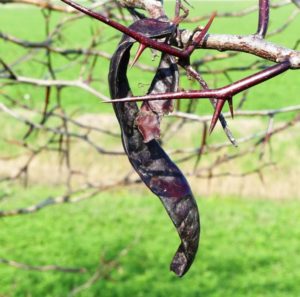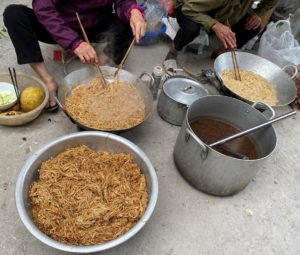Skills
Mollusks in the inland waters of Siberut Island
In rivers, coastal zones, and mangrove forests, a diverse array of bivalve and gastropod species is collected and utilized for food. Bivalvia species Freshwater streams River clams (Batissa violacea) occur in large quantities in the lower zones of all slow-flowing…
Bamboo: The Orang Asli’s natural toolkit
If rattan is the skeleton of Orang Asli junglecraft, bamboo is the toolkit. From riverbanks to misty hill slopes, clusters of bamboo mark places where people have worked, cooked, travelled, and sheltered for countless generations. To an untrained eye, most…
Soapbush – a versatile junglecraft plant
Soapbush (Miconia crenata) is also called Koster’s curse, or, due to its former scientific name (Clidemia hirta), Hairy clidemia in English. It is a highly invasive plant in tropical climates, and many countries have developed eradication programs against this weed….
Rattan: Flexible raw material from the forests
Deep in the lowland dipterocarp forests of Peninsular Malaysia, long before you see rattan, you feel it. Hooks catch on shirt sleeves, flagella tug gently at your backpack, and the forest floor is littered with the thorny sheaths of climbing…
Hand-made fishing hooks from Bali
While travelling to the northern coast of Bali/Indonesia, we met the owner of a general store at the Banyuasri Singaraja Market, whose employee was hammering fishing hooks on a makeshift anvil outside. The owner, Pak (Mr.) Gede Suarka, nicknamed “Lolak,”…
Operation of conch traplines for octopuses
In the following, we will describe the catching operation of octopuses from a fishing vessel with the help of conch traplines. This is the high-end operation of catching these cephalopods, and, based on catching weight, the primary one. But the…
Conch shells for catching Marbled octopuses
Marbled octopuses like to hide in small caves at the seafloor. Fisherfolk use this behavior and offer artificial caves, which they populate. Even while retrieving, the octopuses will not leave their shelter and can be easily caught. Since ancient times,…
Collecting honey from Dammar bees in Sri Lanka
The Rock Vedda people at Rathugala near Gal Oya in Sri Lanka collect honey from stingless Dammar bees. This last remaining band of Rock Veddas in Sri Lanka consists of 68 families, of which only ten of them still live…
Jengkol seeds
Jengkol (Archidendron jiringa) is a tropical tree that grows up to 20 meters high in the rainforests of Southeast Asia. The seeds are mainly eaten in Indonesia, but also in Malaysia, Thailand, Cambodia, and Myanmar. These seeds are called stink…
Improvised firearms of the Orang Rimba people
Improvised firearms are the new hunting weapon of choice for the wild living Orang Rimba people in Jambi province, Indonesia. In one of the following articles, I will present their traditional hunting techniques and typical hunting weapons. Here, I will…
Dangers in the Khao Sok NP in Thailand
About the Khao Sok National Park The Khao Sok National Park is located in the Surat Thani province of Thailand, and about 150 km north of Phuket in a straight line. Cheow Lan Lake on the northern park border serves…
Orang Rimba spring pole snare traps
When we were visiting a band of primitive living Orang Rimba (Kubu) people in Jambi province, Sumatra, Indonesia, each of their shelters had a spring pole snare trap nearby, which was set when they left for a walkabout. The working…
Jungle footwear for Southeast Asia, Part 3
As the topic of jungle footwear is quite an extensive one, it was split up into three articles. The first part covered general requirements, including going barefoot and wearing sandals. The second part covered shoes, including barefoot shoes, rubber shoes,…
Jungle footwear for Southeast Asia, Part 2
As the topic of jungle footwear is quite an extensive one, it was split up into three articles. The first part covered general requirements, including going barefoot and wearing sandals. This second part covers shoes, including barefoot shoes, rubber shoes,…
Jungle footwear for Southeast Asia, Part 1
In the remaining jungles of Southeast Asia, suitable footwear is of utmost importance for local people and outsiders. The rainforest environment has specific requirements that differ considerably from those of other biomes. However, the suggested footwear not only depends on…
Cooking rice in a bamboo
Bamboo is a highly versatile plant that can be used for various applications, including cooking rice in sections of its culms. Near Gerak, in Perak State, Malaysia, I met a street vendor who was traditionally cooking rice. Similar vendors can…
Bubble Green Seaweed on tropical coastlines
On many tropical seashores, green, jelly-filled bubbles can be found. They are either single bubbles or club-shaped bubbles originating from a single center point. In case they are single bubbles, it is a seaweed called Valonia ventricosa, the ‘Bubble algae’,…
Wild yam in Perak’s forests
When walking with Orang Asli people from the Jahai tribe in the forests near the Royal Belum State Park in Perak, Malaysia, they showed me their traditional favorite staple food source: wild yam tubers. These tubers can be eaten without…
Building the sidewalls of simple Jahai huts
Jahai huts, characteristic of the Semang Orang Asli people, exemplify the widespread use of bamboo as a material for floors and sidewalls. The Jahai people settle in and near the area of the Royal Belum State Park in Perak, Malaysia,…
Snake senses
It’s hard to imagine how snakes perceive the world as they slither on the ground, underground, or move through the trees and shrubs. Snakes have extraordinary senses, including perceiving the world in ways that humans cannot. Some of the senses…
Red torch ginger fruits
Red torch ginger (Etlingera elatior) fruits are commonly eaten by Jahai Orang Asli people in the forests of the northern State of Perak in Malaysia. These fruits are not only consumed by the forest dwellers of Perak State, but also…
Harvesting rattan palm hearts
When walking with Jahai Orang Asli people near the Royal Belum State Park in Perak, Malaysia, they showed me some of their plant food sources in the forests. One of them was young rattan palm shoots. For the Jahai people,…
Rattan palm fruits in Perak’s jungles
Rattan palm fruits are available from most of the 70 species of the Calamus genus in Malaysia. But also species of Daemonorps and Korthalsia rattan genera often carry edible fruits. We went with the Jahai Orang Asli people into the…
Wild ginger stalks for food
When walking with the Orang Asli people of the Jahai tribe near the Royal Belum State Park in northern Malaysia, they showed me various edible plants in the rainforest that they ate regularly. One of them was a Zingiberaceae (Ginger)…
Stilt fishing in Sri Lanka
Stilt fishing, locally known as ‘Riti Panna’, was an essential and unique fishing technique on the southern coast of Sri Lanka between World War II and the 2004 tsunami. After this period, this coast was developed into a major tourist…
Moon mushrooms at the Royal Belum State Park in Malaysia
Moon mushrooms (Gymnopus sp.) are one group of edible mushrooms found in the forests of Malaysia, and are locally called ‘Jamur bulan’. The other groups of edible mushrooms are colloquially known as wood ear mushrooms, oyster mushrooms, and shiitake mushrooms….
Fruits eaten by Mentawai people
The fruits eaten by Mentawai people in the forests are various species of bananas, coconuts, durians, and fruits from the rattan palm. Other fruits are also harvested, of which some grow wild, while others are planted and cultivated. Fruits are…
Vegetables eaten by Mentawai people
Cassava (Manihot utilissima) leaves and Fiddlehead ferns are the most essential vegetables for the Mentawai people living in the forests of Siberut Island. Both vegetables were discussed in separate articles on this webpage. Details about Cassava leaves can be found…
Freshwater fishing at Siberut Island
Depending on the location of the longhouse of a Mentawai family, fishing is conducted in any permanent water structure large enough to hold fish, gastropods, or crustaceans. In general, fishing is regarded as the work of men; women fish only…
Carbohydrate food sources of Mentawai
Three of the four most essential food plants for Mentawai people on Siberut Island in Indonesia are carbohydrate sources. Notably, sago is a key provider, with an average composition of approximately 94% carbohydrates, about 7% moisture, and negligible other components….
Snakes on Siberut Island
Bites from venomous snake species appear to be the highest concern when walking in the Siberut forests. There are anecdotal reports that middle-aged Mentawai men were bitten by pit vipers three or four times in their lives. Non-Venomous Snakes (Harmless…
Shrimp pit traps on Sri Lanka’s east coast
Fish, crabs, and shrimp provide the livelihood of small-scale and artisanal fishermen on the east coast of Sri Lanka. Due to specific local conditions, various fishing and gathering techniques have evolved, including the use of shrimp pit traps. Tidal situation…
Forest liana provides food and rubber
Description An extensive forest creeper growing from 20 – 50 m long, scrambling over trees and bushes at the forest edge. All parts exude white milky latex when cut. Bark is smooth and brown. It has brown tendrils up to…
Gathering of Venus clams by finger probing
Venus clams (Meretrix meretrix), correctly named ‘Asiatic hard clams’, are one of Thailand’s most sought-after clams for food. They occur both in the Gulf of Thailand and on the coasts of the Andaman Sea. Fully grown species are large; their…
Vedda flint & steel fire making
Village and Rock Veddas have used flint and steel to produce fires since the end of the 19th century. My former article about Vedda fire drills explains these two different Vedda types. Village Veddas have used this fire-making procedure since…
Vedda fire drills
Until the end of the 19th century, the Vedda people in Sri Lanka used fire drills as their standard fire-making method. In the literature of that time, Vedda was spelled Veddah, and Sri Lanka was called Ceylon. Current situation of…
Beach huts of Zanzibar
Traditionally, the beach huts of Zanzibar are often simple thatched structures made from coconut palm leaves, mangrove poles, and coral stone. Initially, they served as a storage place and shelter for fishermen, who needed them to repair nets, store fishing…
Feral donkey trails leading to water
At the end of the 19th and beginning of the 20th centuries, many draught animals were released in the wild in Western Australia, as motor vehicles took over their work. These included donkeys and camels. Both species flourished thereafter in…
Hadzabe footwear
Hadzabe people use footwear to protect their feet in their living areas. They need adequate foot protection against thorns, sharp plant blades, and edgy stones, as well as against the heat on sand and rock surfaces. In former times, they…
Smoked oysters from the rocks
In the spring of 2025, I traveled to Western Australia to document local survival techniques used by Indigenous people. Across Australia, Indigenous groups are generally categorized into three main types: the so-called ‘Saltwater mobs,’ who live along the coast; the…
Collecting sea urchins in the lagoons
The Collector urchins (Tripneustes gratilla) are a sea urchin species around Zanzibar. Its gonads, which contain either the roe (females) or milk (males), are a delicacy. This sea urchin species is harvested in the hot months of the year, and…
White-spotted hermit crabs
While beachcombing in the lagoons of Zanzibar, we found a White-spotted hermit crab (Dardanus megistos) housing itself in a Fusinus sp. shell. These crabs are exceptionally beautiful, and I therefore want to present them in this article. Description of White-spotted…
Black Lollyfish for food
The Black Lollyfish (Holothuria atra), the Black sea cucumber, is found primarily in the Indo-Pacific region and Zanzibar. It has a distinct cylindrical body, typically black or dark brown in color, with a smooth, leathery texture. It is commonly covered…
Wild sandfish sea cucumbers
Sandfish sea cucumbers (Holothuria scabra) are the most valued species in many tropical coastal regions, particularly Asia. This is based on their use in traditional medicine and as a delicacy. Overexploitation has led to population declines in some areas, prompting…
Freshwater springs in the lagoons
Freshwater springs in the lagoons of Zanzibar are a unique feature of this island. Although such springs exist on many – or even most – coasts worldwide, these Zanzibarian springs can be used as a characteristic example of this phenomenon….
Coastal foraging at Zanzibar
Coastal foraging and fishing are the foremost traditional activities people do on the coasts of Zanzibar. These activities are not restricted to this island or country but everywhere worldwide with a suitable coast. In English, coastal foragers are also called…
Ngalawa boats
Ngalawa boats are extended log boats with double outriggers and lateen sails used by artisanal fishers on the East African coast. They are between 4 and 9 meters long, but most of them are somewhere in the middle between these…
Spearing of African blue swimming crabs
Africanan blue swimming crabs (Portunus segnis) are speared by beachcombers in the lagoons of Zanzibar. These crabs, however, are not the prime target when spearing but only an opportunistic by-catch. The prime target when using spears for fishing is octopuses….
Conch collection for food
Humpbacked conch shells (Gibberulus gibberulus) are true conchs based on the type species Strombus gibberulus. In Swahili, they are called Chuale and are primarily collected by women, who use them for their family’s subsistence and cash income. They are harvested…
Basket fish traps at the seashores of Eastern Africa
Large basket fish traps, with a hexagonal shape and one inverted end, are typically used in Zanzibar and are called ‘Dema’ in Swahili. These fish traps, which have a large mesh size, were initially made from palm leaves and mangrove…
Fruits eaten by Hadzabe people
Besides honey, meat, Baobab fruits, and tubers, berries are one of the significant food classes that the Hadzabe people eat. Honey is the most important one for both Hadzabe males and females. However, females relish berries as the second most…
Sea hare without caviar
Sea slugs of the taxonomic family Aplysiidae are commonly called ‘sea hares’, because when underwater, their rounded body shape and the long rhinophores on their heads resemble that of a sitting rabbit or hare. Unlike other sea slugs (nudibranchs), they…
Catching octopuses in the lagoons
Catching octopuses in the lagoons of Zanzibar is an age-old and sustainable activity mainly carried out by adult women. Depending on the number of caught animals, they are used to feed the family and sold to restaurants and fishmongers. As…
Water disinfection by UV-rays from the sun
One method of disinfecting water from biological hazards is utilizing UV rays from the sun, known as SODIS (Solar Disinfection). The principle of water disinfection by solar radiation was first discovered in 1984 by Prof. Aftim Acra of the American…
Sea lettuce for salad
Sea lettuce (Ulva lactuca) is common on most shorelines worldwide. This article focuses on the island of Zanzibar in Tanzania. There, sea lettuce is used as an export article and supplementary food for humans. In addition to being collected in…
Top 10 rare snakes of Southern Africa
We often get asked what the rarest snakes in southern Africa are. This is hard to quantify, as some species may be locally abundant but in areas rarely visited. Other species may live underground and only become active above ground…
Edible red seaweed on Zanzibar beaches
In Zanzibar, two edible red seaweed species are commonly used for food: Spinosum and Cottonii, also called ‘Elkhorn sea moss.’ Both species can be found wild in the coastal area and are also farmed intensively. In addition to these two…
Bamboo rat for dinner
Bamboo rats are a common rodent in bamboo thickets in mountainous areas of northern Vietnam. Hmong tribal people in remote regions still hunt them regularly for food. Although hunting bamboo rats is officially prohibited, the practice is still widespread. To…
Creating fire with a magnifying glass
A magnifying glass has been used to start fires since ancient times. Greek and Roman writers recorded the use of ‘Burning glasses’ for domestic and war purposes. A concise history of these applications can be found on Wikipedia. Nowadays, fires…
White truffle hunting in Istria/Croatia
White truffles (Tuber magnatum) are the most highly-priced truffle species. In total, six different truffle species occur on the Istra peninsular. Four of them are variations of Black truffles (T. aestivum, T. aestivum var. uncinatum, T. melanosporum, T. brumale), and…
An oyster species growing on Mangrove trees
Mangrove oysters (Isognomon ephippium) are the species most commonly found growing on mangrove trees in Northern Australia. Its other common English name is ‘Saddle tree oyster.’ These oysters are one species eagerly collected and eaten by Bardi people at the…
Edible Rubber Vine Fruits in Central Africa
Landolphia camptoloba (Apocynaceae) Common names: Mbungumbungu, dinsania, dinsona (Kongo). Magoki is also used for all Landolphia species with edible fruit. Description A slender vine or shrub growing from 30 cm to 8 m long. Mature fruits, 5 cm in diameter,…
Edible Ferns of Papua New Guinea
Some times ferns are eaten in large quantities. At highland pig kills, ferns are one of the most common edible greens. Some ferns are only eaten with meat. Some other ferns are eaten more regularly and are very much liked….
Are snakes dangerous?
Snakes are mysterious creatures – secretive and elusive and, of course without legs, yet they can slither quickly, disappear down holes, swim effectively and climb trees. Many snakes are venomous and some highly so. Fear of snakes There are many…
The various uses of Oil palms in D.R. Congo
Elaeis guineensis (Arecaceae); Common names Ba di nsamba, ba di ngasi (Kongo), palmier à huile (Fr.), oil palm Ecology In Kongo Central scattered trees are commonly left in the bush fallow. Propagation Seed requires heat treatment before it will germinate…
Origin of Bananas
Most areas of Papua New Guinea have bananas. Some people have them as their main staple food while in other areas they are just a snack food. There is a very large amount of variation within the banana varieties in…
First Aid for Snakebite
Back in the nineteenth and twentieth century people tried various remedies to treat snakebite. This included cutting and sucking at the site of the bite, rubbing in Condy’s Crystals but the all-time favourite was a tight arterial tourniquet high up…
Long-spine Porcupinefish on the coast of Zanzibar
The Long-spine porcupinefish (Diodon holocanthus) is one of the many seafood organisms local people catch or collect at low tide in shallow waters around Zanzibar island. This fish is not specifically searched for, but it will be happily speared and…
Datoga spears
These spears have a long history but were replaced for hunting by bows and arrows in modern times. Nowadays, their primary purpose is personal protection against predators when traveling on foot for longer distances. The author encountered a couple of…
Datoga huts
The Datoga are pastoralist people living in various regions of northern Tanzania. Their estimated population is about 30,000. One of their main settlement areas is on the eastern shore of Lake Eyasi. Datoga settlement areas consistently face pressure from the…
Bow hunting equipment of the Datoga tribe
Datoga people are spread over a wide area on the Masai steppe in Northern Tanzania. Their main stronghold is around Lake Eyasi. There, especially in the Yaeda Valley, they live close to the Hadzabe people. Masais pressed Datogas into less…
Hadzabe Axes
Hadzabe axes are part of the standard outfit of every Hadzabe man living in remote areas. This outfit consists of his bow, a bunch of arrows of various types, a firestick, his knife, and the axe. Additionally, he will carry…
Hadza hand drill friction fire
Hadza hand drill friction fires are the standard fire-making method of the Hadzabe people in Tanzania, who live remotely. They do not have the omnipresent butane gas firelighters of the modern world or any other artificial methods. Even when lighting…
Hadza Arrow Poison – Strophanthus and Acokanthera species
Arrow poison based on Adenium sp. plant extracts was covered in a former article on this website. In the following, we will discuss the second type of poison the Hadzabe people make, which they call Shanjoko, a Strophanthus species. Additionally,…
Hadza Arrow Poison made from Adenium species
Remotely living Hadzabe people use three types of arrow poison to bag big game animals. However, due to the shrinkage in the size of their areas, they currently produce only two kinds. I will describe these arrow poisons briefly to…
Hadza style of shooting bows
Shooting bows by remotely living Hadza boys and men is a daily, necessary affair. From the age of three, they start shooting bent sticks. As youngsters, they are soon required to contribute meat to the family. Through this early and…
Cold-forging of iron arrowheads
The Hadza people, who live in remote areas, produce iron arrowheads themselves. Contrary to what is often mentioned in the literature, they do not buy these iron arrowheads from the Datoga people. Both tribes used different production methods. Whereas the…
Hadzabe arrow shafts and fletchings
Arrow shafts are a piece of Hadza men’s identity. Remotely living Hadza men always carry their bows, arrows, and firesticks. Whenever they have leisure time, they attend to their arrows by building new ones, checking and correcting their straightness, or…
Types of Hadzabe Arrowheads
Hadzabe people use four basic arrowhead types, which are further divided into different styles. All of these types and styles serve specific hunting applications. 1st basic type of Hadzabe arrowheads: Wooden arrow tips These types of arrowheads are called hik’o…
Hadza bows for hunting
Hadza bows are not only used for hunting but are also ubiquitous adornments for nearly all Hadza men. They even carry their bows, arrows, and firesticks around when they are not going to hunt. The bows are often short-lived and…
Hadza hunting techniques
Hadza people in remote areas of Tanzania are one of the last remaining hunter-gatherer tribes in Africa. However, only about 25% of Hadza people live this original hunter-gatherer life. That means, from a total population of about 1300 Hadzabe in…
Baobab seeds and pulp porridge
Baobab seeds and vine roots are staple foods for remotely living Hadza in Tanzania. This article already presented the collection and preparation of vine roots. In the following, we will discuss how to prepare Baobab seeds and their surrounding dry…
Sweat Bees – not a danger, but a nuisance
Correctly named Sweat Bees are Halictid Bees, an extensive and diverse family of bees. These small—to medium-sized bees are often the most common flower visitors and essential pollinators. About one-third of all bee species in East Africa are halictids. However,…
Stingless bee honey collected by Hadza people
The Hadzabe people eagerly collect stingless bee honey all year long. They do this destructively by cutting open the hives in tree hollows, and both honey and brood are harvested and eaten. Foraging on these insects has not significantly affected…
Traditional Hadza camps and huts
Traditional Hadza camps are loose affiliations of relatives, in-laws, and friends. Each camp has a few core members, but most others come and go as they please. If there are conflicts, the feuding parties will resolve them by simply separating…
Hottentotta trilineatus scorpions at Yaeda South in Tanzania
We found Hottentotta trilineatus scorpions when camping on a rocky ridge in the Yaeda South area. The place where we put up our tent was about 2 km / 1.2 miles from the next Hadza camp and in the middle…
Hadza water sources
The Hadzabe (plural of Hadza) natural environments are the escarpments and rocky, wooded hills that form the watersheds for Lake Eyasi and Yaeda Swamp in Tanzania. In this Rift Valley environment, seasonal rainfall changes and surface water availability from runoff…
Climbing a Baobab tree
A Baobab tree (Adansonia digitata) is characteristic of African Savannah biomes. In Tanzania, the Hadza people in the mountainous southern area of Lake Eyasi taught us to climb these trees. Although it is not difficult, knowing the techniques for a…
Wild Sweetpea tubers as food for Hadza people
Wild Sweetpea (Vigna frutescens) tubers are a staple source of starchy food for the Hadza people in Tanzania. The plant’s common name in the Hadza language is //ekwa. To collect them, groups of Hadza women regularly head out into the…
Orang Rimba shelters in the forests of Sumatra
Orang Rimba (locally called Kubu) shelters and dwellings in the forests are designed in different styles rooted in their semi-nomadic lifestyle. These structures can be divided into two main groups: semi-permanent structures and shelters when they are on the move….
Tu-Lip trees in Papua New Guinea
Tok Pisin: Tu lip; Scientific name: Gnetum gnemon What does a tu-lip tree look like? It is a small tree often only 8-10 metres high. It is a fairly straight tree with one trunk that has branches spread out along…
Traditional Remedies for Snakebite
A recent social media post claimed that, following a snakebite, chewing the bark of a cashew nut tree would neutralize the venom of the snake and ensure the full recovery of the victim. In many tropical African countries, cashew nut…
Visiting Orang Rimba people in Jambi province
Who are the Orang Rimba people? The expression ‘Orang Rimba’ means ‘People of the rainforest,’ but this name is primarily used by scientists internationally. In Indonesia, the people call them ‘Kubus,’ which means being outside or on the fringe of…
Collecting honey in a rock crevice
Asian honey bees and their combs are a special treat for the local population of backcountry areas at Pu Luong Nature Reserve in northern Vietnam. The harvested honey is seldom sold and is mainly used by the villagers. The grubs,…
Harvesting Shipworms in a Thai Mangrove Forest
Edible shipworms, in this case Bactronophorus thoracites, are also known as Naked clams, Priyang talay (เพรียงทะเล), and various other common names throughout the region where they occur. They bore into wood immersed in salt water and are a major hassle…
Hog plums for food
Spondias mombin (Anacardiaceae); Common names: Mungyenge (Kongo), Hog plums Description A tree which grows to 25 m. Flowering occurs during the dry season. Fruiting of hog plums starts after about 5 years though cuttings may produce earlier. The tree has…
Disinfecting water with Potassium Permanganate
Potassium permanganate is an essential chemical for various simple living applications. One is its disinfecting effects, and the other is the possibility of chemically starting fires. This article discusses disinfecting water on a small scale for drinking purposes. We will…
Small black snakes of Southern Africa
The small black snakes, which are found across Africa, are tricky to learn to identify. The danger lies in the fact that most species are harmless or mildly venomous, but can be easily confused with the venomous stiletto snakes. Many…
Collecting Pipi clams at Rawai Beach
Pipi clams (Donax deltoides) are also known as Surf clams, Sandy Donax, and a wide range of other common names. In Thailand, they can be found on most beaches in the Gulf of Thailand and the Andaman Sea. They are…
Bottom fish traps of the Urak Lawoi people
The following information was gathered from a Urak Lawoi man who has lived in the Rawai Beach Sea-Gypsy Village for 27 years. He was 57 years old and only had one tooth (incisor) left in the middle of his upper…
Rectangular squid traps in Thailand
Rectangular squid traps are used in the Gulf of Thailand and along the coastline of the Andaman Sea in the same way as semi-circular traps. Both types are used mainly for catching Bigfin reef squid (Sepioteuthis lessoniana) but will also…
Catching mud crabs at Koh Lanta
Mud crabs are common in mangrove areas in Thailand. They are primarily caught in crab pots for commercial purposes. However, my Urak Lawoi friends and I specialized in digging up and catching these crabs by hand. Who are Urak Lawoi…
Giant Fennel pith for transporting fire
While researching various bushcraft and survival topics, I constantly encounter inconsistencies and errors on reputable websites. Therefore, I have gotten into the habit of checking many postulates myself. One of these statements is that Prometheus brought fire to Earth with…
Red-tailed pipe snake
The ‘Red-tailed pipe snake’ (Cylindrophis ruffus) was recently renamed ‘Jodi’s pipe snake’ (Cylindrophis jodiae), which we are talking about here. It is called a ‘Pipe snake’ because it has a round, pipe-like body. The lower end of the body can…
Ambarella fruit in the Mekong Delta
Ambarella fruit (Spondias dulcis Parkinson; syn.: Spondias cytherea) is native to Melanesia and Polynesia and was introduced worldwide throughout the tropics. Its other common English names are Jew plum and Golden apple. In the Mekong Delta, it is omnipresent in…
Trapping eels in Northern Vietnam
Trapping eels is a simple way for rice farmers in the catchment area of the Red River in North Vietnam to provide themselves with animal protein. No special skills are required, as with angling or net fishing. The activity is…
Advanced Rifle Handling (ARH) for Trail Guides
Hikes through natural areas in Southern Africa where dangerous game is present must be conducted with at least one, but usually two, armed trail guides. One is the “Lead Guide” or “1st Rifle,” and the second is called the “Back-up…
Bow Drilling – following the method of Mattias Norberg
At the Global Bushcraft Symposium 2022 in Wales/UK, the Swede Mattias Norberg demonstrated his method of creating fire by bow drilling. Sweden has a rich outdoor tradition, and it was a privilege to meet him there, as he has deep…
Giant Fennel stalks for lighting fire
Various internet pages and YouTube channels describe lighting fire with stalks of giant fennel (Ferula communis) as easy. I doubted these claims, so I tested them myself. The outcome was sobering, which I will describe in the following article. I…
Vine snakes of Africa
Vine Snakes (previously called Twig or Bird Snakes) are widespread across Africa and are usually found in warm savannas and forested areas. There are currently four species and one subspecies of Vine Snake in Africa. The status and distinguishing features…
Giant Fennel stalk wood as building material
Giant Fennel (Ferula communis) is a common weed in Mediterranean countries and Central Asia. Except for one genetic variety in Sardina, all green parts of the plant are strongly haemotoxic and lead to the poisoning of livestock and humans. This…
Edible rock snails in limestone areas of Vietnam
Rock snails of the genus Cyclophorus are highly sought-after wild foods in rocky limestone mountain areas of Vietnam. These snails are not only regarded as food but also as medicine against various ailments. The local Vietnamese name is Ốc thuốc,…
Blowpipe hunting with Orang Asli people in Malaysia
Blowpipe hunting is still prevalent in many Orang Asli communities in Malaysia. Although the government strictly enforces hunting rules and regulations, it is practically impossible to supervise all the remote small hamlets and villages. On the other hand, it is…
Collecting Bibi worms on Koh Lanta
Bibi worms (Sipunculus nudus Linnaeus, 1776) belong to the Peanut worm phylum. They can be dug up at the intertidal zone of flat, sandy beaches on temperate and tropical beaches. These worms are primarily used as top fishing bait. At…
Wild asparagus in Sicily
Wild asparagus, a unique culinary delight, is prominent in Sicily’s springtime cuisine. The region boasts two distinct species: Asparagus albus, White asparagus, and Asparagus acutifolius, affectionately dubbed ‘Wild asparagus’ in English. Another edible part of these plants is its ‘crown’…
Stone huts at Mount Etna in Sicily
Stone huts on the northern side of Mount Etna in Sicily were built at least since pre-Hellenic times, around 4,000 BC. The building materials were basalt blocks from eroded lava at this location. The builders used dry-stone wall construction without…
Ginger flowers add zest to food
Ginger flowers are eaten in many Southeast-Asian cultures. In Indonesia, most ginger varieties are known from Siberut Island. The native population of this island has utilized the flowers of Torch Ginger (Etlingera elatior (Jack) R.M. Sm.) since ancient times for…
Young Cassava Leaves provide protein and micronutrients
Young cassava leaves are a regularly eaten side dish for Mentawai people. Cassava (Manihot esculenta, Crantz) is endemic to the southern rim of Amazonia in South America. There, it was domesticated around 5000 BC. In the 16th century AC, Spanish…
Vegetable ferns are a source of nutrients in Siberut
Vegetable ferns (Diplazium esculentum (Retz.)) are among the few wild vegetables Mentawai people in the forests eat regularly on Siberut Island. By Mentawais, they are called ‘Laipat.’ Other wild vegetables are cassava leaves, ginger flowers, taro stalks, and wild eggplants….
Scissor Traps of Thái Đen tribals in Vietnam
Scissor traps are universal traps that can catch all kinds of small rodents. They are easy to produce from bamboo but need one item to be sourced in the villages. These are strips of bicycle tubes, which are not easy…
Bow Traps of Thái Đen tribals in Vietnam
Bow traps are used by Black Thai tribal people in Northern Vietnam to catch small rodents. These ingenious devices are carved from pieces of bamboo and some strings. The closing force of the scissor comes from a bow-like structure above…
Domestic pigs as food by Mentawais
Domestic pigs are a typical gift from a Mentawai family to a shaman for his support or services. In our case, Aman Aru attended a ceremony in a neighboring Uma (family home in the forests), which had to be cleaned…
Deadfall Traps of Thái Đen tribals in Vietnam
Deadfall traps with a Figure-4 trigger are essential knowledge for survivalists and bushcrafters worldwide. Thái Đen (Black Thai) tribal people at Pù Luông Nature Reserve in Northern Vietnam use these traps and the Figure-4 trigger in a modified version. Modifications…
Mentawai forest huts
The Mentawai people at Siberut Island use forest huts (called Sapou by them) for various reasons and purposes. One is a permanent dwelling for single, old men who do not live with their family in the Uma (family home in…
Rattan fruits in Siberut jungles
Rattan fruits are available throughout the year in all Southeast Asian rainforests. There are about 600 different species of rattans, and many of them bear edible fruits. However, rattan prickles are a common nuisance when walking in the jungle. Nevertheless,…
Giant snakes
Seeing movies like Anaconda let many people believe that there are monster snakes in jungles, some even exceeding 10 m in length. However, those stories have been doing the rounds for many years. So much so that the New York…
Carrying baskets of Mentawai people
Mentawai people use five types of carrying baskets, which they call Opa, Tuku, Jarakjak, O’orek, and Bolokbok. Opa – the standard-sized carrying baskets. Opa are the most popular type of carrying baskets. They are entirely woven from Calamus javensis rattan vines collected from…
Cutting- and chopping tools at Siberut Island
The cutting- and chopping tools used by forest dwellers include adzes, axes, machetes, and a specialized knife. All of these tools have a strong historical background and are still in use today. Axes People primarily use axes (Oggut) to fell…
Sago worms of an unidentified species at Siberut Island
Sago worms are one of the food items that come naturally with the Mentawai’s staple food, sago flour. The worms grow in felled palm trunks or saplings. They are not worms but larvae and pupae of the Palm Weevil beetles…
Chicken as food by Mentawais
Domestic chickens are omnipresent around every Uma (family home) in the forests of Siberut Island. During nighttime, they are kept in closed coops to protect them from predators like civet cats. While staying with Mentawais, I observed no nesting boxes…
Rattan leaf stalks for coconut grating
Rattan leaf stalks have been, since immortal times, the tools with which Mentawai people have been grating coconuts. These long-lasting tools grate the coconuts into the required size of flakes. When worn out or broken, a new one will be…
Taro – another staple food of the Mentawai people
Taro (Colocasia esculenta (L.) Schott) is one of the three staple food items of the Mentawai people on Siberut Island in Indonesia. The other two are sago and bananas. In many other countries, taro leaves and corms are eaten. Mentawais…
Roasted Sago sticks on Siberut Island
Roasted sago starch is the staple food for Mentawai people living in the moist, tropical forests of Siberut Island, off the coast of Western Sumatra in Indonesia. On the other hand, sago, boiled to porridge, is eaten as a staple…
White Ginger Lily for cleaning hands
White Ginger Lily (Hedychium coronarium J. Koenig) belongs to the Zingiberaceae (Ginger) botanical family. Mentawai people use the crushed stem to clean their hands after touching arrow poison or one of its two poisonous main constituents. In another article on…
Danger of Asian elephants – whether they are in musth or not
Asian elephants (Elaphas maximus) are smaller than their African cousins but not less dangerous when in musth. That danger was already described for African elephants in this article on this website. In the following, we briefly compare the differences between…
Mentawai arrow poison
The Mentawai people use poison on their arrows to hunt game. In previous articles on this website, we discussed the Mentawai people’s hunting methods. Then, we presented an actual hunt for Flying foxes. We then discussed the longbows used on…
Hunting arrows and quivers of the Mentawai people
Bows and arrows are the primary hunting weapons used by the Mentawai people. Their bows were already described here. This article will explain the different types of arrows used for these bows and give an insight into the quivers used….
Mangrove apples at the Mekong Delta
Mangrove apples are the fruits of Sonneratia sp. trees, one of the important genera of trees in the Mangrove forests of Southeast Asia. All species of Sonneratia will develop edible Mangrove apples. The various Sonneratia species differ slightly in shape,…
Animal species collected by rice farmers in the Red River Delta
Rice farmers in secluded areas of the Red River Delta in Northern Vietnam need dietary additions to their staple rice dishes. Vegetables are harvested from around their homes and surrounding tropical Evergreen forests. Animal proteins are mainly collected in and…
Natural shampoo from a Soap plant (Gouania leptostachya)
Natural shampoo can be extracted from a variety of plants worldwide. In the evergreen forests of Lowland in Northern Vietnam, we used the leaves of a so-called soap plant. With these leaves, we regularly washed our hands and bodies. In…
Egg carton fire starters
Fire starters are convenient aids in Austria’s cold winters. Wood shavings lighted wood- and coal-burning stoves one generation ago. These shavings lighted spruce kindling, which in turn started burning bigger pieces of wood. Nowadays, it’s easier. Either commercially available or…
Building a specialized fishing boat at Padang
In Indonesia, there is a wide variety of traditional fishing boat designs. Most of them are variations of standard types adapted to local needs and conditions, and many of them have not been systematically described yet. This article presents one…
Stinging Nettle Slug Caterpillar in Vietnam
When hiking in Pu Luong Nature Reserve in northern Vietnam, we found a species of Stinging Nettle Slug Caterpillar on a Banana leaf. My local friends got highly nervous when they saw it, and I was intensely warned against touching…
Boiling water in bamboo
Boiling water in green bamboo stems (‘culms’ would be the botanically correct term) is not a significant skill, but it represents the basic cooking technique in Southeast Asian forests. One of the following articles will build on that and explain…
Trapping Snakeskin Gourami in the Mekong Delta
Trapping Snakeskin Gourami fish (Trichopodus pectoralis) is commonly done all over Southeast Asia. However, a specific trap for catching them was developed in the Mekong Delta in Vietnam. Its simple principle could be easily applied to many other areas of…
Green-billed Malkoha bird on the spit
The Green-billed Malkoha is a common bird in Vietnam’s semi-deciduous tropical forests. An expedition led to the capture of one who was cooked for lunch. This and other species are often hunted by villagers supplementing their diet with this and…
Catching Octopuses by Sea-Gypsies
Sea-Gypsies – Urak Lawoi, Moklen, and Moken – traditionally catch octopuses along the Andaman Sea’s rocky shores, which they call โวยวาย in the Thai language. Using a metal skewer and baited bamboo stick, they locate octopuses in holes with foam…
Mentawai Hunting bows
Hunting bows are the primary hunting weapon for the Mentawai people and are very personal items for a hunter. They have excellent skills in using them and practice shooting from childhood onwards. During my stay with the Mentawais, I looked…
Flying fox hunting
Flying fox hunting remains a prevalent activity in Indonesia, particularly in Sumatra. Aceh, the northernmost province, is the epicenter of the trade in Flying fox meat. Locals believe that this meat possesses qualities to alleviate asthma, although this claim lacks…
Hunting methods of Mentawai people
The hunting methods of the Mentawai people have developed over about 3000 years. Their ancestors were of a Mongolian race that migrated from Taiwan via the Philippines to modern-day Indonesia. They arrived around 1000 BC at Siberut island in West…
Holiday time and snakes
As the holiday season starts, many people will be returning to their family homes or are off on vacation. Snake season is in full swing with decent temperatures and sporadic rain. We are currently seeing a number of snake bites…
Fongaar – not a yam, but kind of sweet potato
Tok ples: Fongaar Scientific name: Ipomoea macrantha Roemer & Schultes; Synonyms: Ipomoea tuba (Schlechtend.) G. Don; Plant family: Convolvulaceae What is the plant like? The plant has a long angular vine 5 to 6 metres long and it climbs up…
How Mentawai people assemble roof thatching panels
Roof thatching is vital for shelter waterproofing in the Mentawai tribe, which has around 6,000 members, on Siberut Island, Indonesia. Siberut lies about 100 miles (160 km) west of Padang in West Sumatra. Of the 6,000 Mentawai people, roughly 1,000,…
Raphia sese – a very special Raphia palm
Raphia sese (Arecaceae) Common names: Nsaku (Kongo = knife with a long blade), ba di magangu (Kongo). Description A palm which grows in dense clumps up to 10 m tall. Female flowers are produced at the base and male flowers…
Mambas of Africa
“Muhle wena kona hamba,skati wena bona mamba,noko wena hayi tshetsha,wena ifa lapa stretsha.” African proverb “It’s advisable to hamba (walker),when you stumble on a mamba,for if you do not tshetsha (move),you’ll expire on a stretcher.” Mambas have a bad reputation…
Pitpit – Edible grasses in Papua New Guinea
Three types of pitpit grow in Papua New Guinea: Coastal pitpit The pitpit plant looks like sugarcane to which it is related. Normally the stalk is thinner than sugarcane. It can grow up to 3 metres high and produces suckers…
Batwa pygmies traditional fire lighting method
The Batwa people live around Bwindi Mgahinga National Park in Uganda. This park is significant because it houses half the world’s mountain gorilla population. The Batwa were the last tribe permitted to hunt in this national park before they were…
African milkbush causes painful blistering and inflammation
Euphorbia tirucalli (Euphorbiaceae) Common names: Ngego, ngewu, nlembonlembo (nlembo = finger) (Kongo), Euphorbe effilée, tirucalli (Fr), finger tree, finger euphorbia, African milkbush Description A leafless succulent shrub with cylindrical shoots, 2 – 8 m tall. All parts produce copious white…
Some varieties of edible wild mushrooms in DR Congo
Some mushroom collectors And some sellers Bunsambi (Polyporus tenuiculus) grows on dead tree trunks (particularly Voacanga africana) and can be found throughout the year. It is cooked with simsim or seeds of pumpkin or squash. Lumvumvu (Lentinus squarrosulus) Grows on…
Wild Karuka and another pandanus fruit species
The Pandanaceae botanical family comprises the following six species in Papua New Guinea: ‘Karuka’ and ‘Marita’ were already discussed on this website in two former articles. ‘Karuka’, see here, and ‘Marita’ see there. In the following, ‘Wild Karuka’ and Pandanus…
Some important edible caterpillar species in Kongo Central, Part 2
In former articles on this website, we already discussed two edible caterpillar species from Kongo Central. One species was ‘Bisu’ Nudaurelia petiveri, which was described here. And the other species was ‘Kaba’ Lobobunaea phaedusa, described in this article there. Additionally,…
Snake Teeth and Fangs
Most snakes have quite long, thin, sharp, and recurved teeth for catching and eating prey. These teeth are firmly anchored to the anterior bone on the lower jaw and the upper jawbone. Just like sharks and crocodiles, snakes replace their…
Karuka – cultivated pandanus fruits and nuts
Tok Pisin: Karuka Scientific name: Pandanus jiulianettii Two species of pandanus are commonly used for the nuts that are eaten. They are Karuka (Pandanus jiulianettii Martelli) and wild Karuka (Pandanus brosimos Merr & Perry). At least 3 other species of…
Some important edible caterpillar species in Kongo Central, Part 1
In former articles on this website, two edible caterpillar species from Kongo Central were already discussed. One species was ‘Bisu’ Nudaurelia petiveri, which was described here. And the other species was ‘Kaba’ Lobobunaea phaedusa, described at this article there. In…
About snake home ranges and territories
We are often asked whether snakes have a specific territory. The word territory is perhaps not the correct term as it infers that snakes would protect this area to keep other snakes out of it. Snakes do not live in…
Catching Ghost crabs by digging
Ghost crabs (genus Ocypode) comprise 22 different species, and they are commonly also called `Sand crabs.` The scientific name Ocypode has Greek origin and means swift-footed. Ghost crabs are semi-terrestrial crabs that dig deep burrows in intertidal zones of sand. They…
Giant Taro – a plant with a giant root
English: Giant taro; Scientific name: Alocasia macrorrhiza (L.) Schott; Synonyms: Alocasia indica (Lour.) Spach; Plant family: Araceae Description of Giant Taro plants A very large herb of the taro family. It has a stout erect trunk up to 4 m…
Snake Season in Southern Africa
Spring (Sept/Oct in the Southern Hemisphere) is snake season and as the temperature rises, snakes leave their underground shelters in search of food. It is a slow process and they become more active as the temperature increases. Once the first…
Three-spot swimming crabs on surf-beaten sandy beaches
Description of the crab species Three-spot swimming crabs (Ovalipes trimaculatus) have a rounded triangular carapace with five legs on either side. The tips of the back pair of legs are flattened into paddles for better maneuvering in the water. Adorned…
Swiss pine cones and their uses
The Swiss pine (Pinus cembra) goes by different names in German-speaking countries, such as ‘Zirbe,’ ‘Arve,’ ‘Arolla pine,’ or ‘Austrian stone pine.’ For generations, people have used the nuts of this particular pine species as food during the winter months,…
Bushmeat snaring
Bushmeat snaring is a widespread hunting method in Sub-Saharan Africa. Public landscapes in this part of the world are often devoid of larger wild animals due to bushmeat hunting. This is so bad in some places that mammals – even…
The Green Mamba
The Green Mamba (Dendroaspis angusticeps) was described by Sir Andrew Smith in 1849 from animals collected from Natal. Taxonomy The Latin name angusticeps comes from “angustus” meaning narrow and “ceps” an abbreviation for head – narrow head. Surprisingly, many years…
Elephant diggings in dry riverbeds
African elephants (Loxodonta africana) require approximately 40 to 60 gallons (150 to 220 liters) of water daily to maintain their health. They obtain this water from various sources, including open water bodies and wells dug in sandy riverbeds. Additionally, elephants…
Use of Tsamma melons in Namibia
Tsamma melons are the original progenitors of watermelons. Historical records indicate that these melons were already under cultivation in the Nile Valley as far back as 2000 BC. In contemporary times, Tsamma melons continue to be utilized for their oil…
Preventing Snakebite in Southern Africa
Snakebite was recently recognized as a neglected tropical disease by the World Health Organization with about 20,000 snakebite fatalities reported every year in Africa. Subsequent morbidity affects far more people than that. In South Africa we have around 4 000…
Neolithic fishhooks in Korea
During the Neolithic Age (8000 BCE—1400 BCE), people across various regions began to adapt to the evolving natural environment following the Ice Age. This era is characterized by the emergence of earthenware artifacts and groundstone tools and the establishment of…
Marita – a lesser known pandanus fruit
English names: Marita or ‘Red Fruit’ Tok pisin name: Marita Bahasa Indonesia name: Buah Merah Scientific name: Pandanus conoideus Lamarck The marita pandanus plant A short much branched screw pine with many prop roots. The prop roots have prickles. Trees…
Seekoraal plants in Southern Africa
Seekoraal is the Afrikaans term for the Salicornia natalensis plant, which belonged to the Sacocornia taxonomic genus before being reclassified under the Salicornia genus in 2017. Salicornia plants are succulent, halophytic (salt-tolerant) flowering plants in the Amaranthaceae family. They thrive…
Yam varieties in Papua New Guinea
Four species of yam are commonly grown and used for food in Papua New Guinea – but often naming in villages and naming by scientists do not agree. Many village people regard potato yam and 5-leaflet yam as varieties of…
Solomon’s Sago – another Sago palm species
How is this sago different? The Solomon’s sago palm that occurs in the North Solomon province and the Solomon Islands is quite different from the sago that grows in other areas of Papua New Guinea. It has a different scientific…
Sago – staple food in parts of Papua New Guinea
There are two Sago palm species in Papua New Guinea. Metroxylon sagu Rottb. and the other one occurs in North Solomons Province and the Solomon Islands. Its scientific name is Metroxylon salomonense. The sago palm plant The sago palm grows…
Utilizing Horseshoe Crabs as a Food Source
Foreword Horseshoe crabs are a species not protected in Thailand and are experiencing a significant decline. Their primary habitats, particularly the mudflats around mangrove forests, where they live and reproduce, are diminishing, and there is a growing demand for edible…
Using a stomping basket to catch fish in Vietnam
Fishing with a stomping basket has been a traditional craft in Vietnam for centuries. Postcards from the French colonial era depict this unique fishing method as a typical way for locals to catch fish. While similar techniques exist in other…
Giant Snakehead fishing in Thailand
The Giant Snakehead fish (Channa micropeltes) is a highly aggressive and predatory freshwater fish. Its diet mainly consists of smaller fish, frogs, crustaceans, and aquatic prey. In Malaysia, Singapore, and Indonesia, this fish is known as the ‘Toman’ and, along…
Shore fishing for Bronze Whaler Shark
Bronze Whaler Sharks (Carcharhinus brachyurus), also known as Copper Sharks, are sought-after game fish for recreational anglers in many parts of the world. They are known for their impressive strength and fighting abilities, which challenge anglers. These sharks can reach…
Catching Tigerfish at the Zambezi
Tigerfish hold a similar significance for Africans as the bass for Americans or carp for Europeans. These three fish species effectively represent the human populations on their respective continents. Tigers are my favorite, as they possess a remarkable blend of…
Making bow strings from plant fibers
The manufacture of bow strings from plant materials is a skill that Bushmen have practiced for a relatively short period. Around 1900, they learned from neighboring Bantu-speaking tribes how to use Sansevieria fibers to create bow strings. Before this, they…
Sweet ‘White Berry Bush’ fruits
Synonyms White Berry bush, Snowball bush (Eng.); Witbessiesbos (Afrikaans); Chinese waterberry (China), Goowal (Yawuru Australia); Flueggea virosa (Lat.) – Flügge was a German botanist, and virosa means poisonous or having a bad odor. Distribution Flueggea virosa commonly grows in deciduous…
Mahout training at Lampang province
The National Elephant Institute of the Forest Industry Organization of Thailand conducted mahout training for amateurs near Lampang. This institute was initially established as a training center for elephants working in the timber industry, where they learned how to lift,…
Composition of Bushmen Arrows
The topic of the composition of Khoi-san (Bushmen) arrows for hunting is vast and intricate. Numerous anthropological studies have documented the unique designs utilized by nearly every family group of Khoi-san in Southern Africa. These designs are often a result…
Making bushmen bows for hunting
Generally speaking, the Khoi-san (‘Bushmen’) employ bows and poisoned arrows for “tracking and stalking” during hunting in Northern Namibia and North-Western Botswana. The various Khoi-san tribes utilize different materials and techniques for crafting these weapons. However, in this article, we…
Eating centipedes in Yunnan Province, China
Eating insects and centipedes is a long tradition in Lijiang City, in Yunnan Province, P.R. China. In addition to centipedes, other insects such as bamboo worms, silkworm pupae, and locusts are also consumed. While they are high in protein and…
Bushmen hunting techniques in Namibia
In earlier times, the Ju//hoansi Khoi-san (Bushmen) of North-East Namibia employed four distinct traditional techniques for hunting animals. These techniques have remained unchanged, as even today (in 2023), the Ju//hoansi continue to eschew the use of firearms, sticking to their…
Sourplum fruits for food and oil
Sourplums, which belong to the Olacacea family, comprise two species: the Blue Sourplum (Ximenia americana) and the Great Sourplum (Ximenia caffra). Blue Sourplum The Blue Sourplum is naturally distributed in semi-tropical and tropical countries worldwide, as shown on the map….
Beachcombing for Vongole clams in Northern Italy
Vongole clams (Ruditapes philippinarum) are the main bivalve species collected from the flat beaches of the Adriatic Sea in Northern Italy. Introduced to aquaculture facilities in the lagoon of Venice in 1983, they are now considered an invasive species, having…
How to find freshwater on sandy beaches?
Freshwater seepages occur along drainage lines on beaches, where the water table meets the sea. These seepages are fed by freshwater supplies from inland, and the land beyond the sea is naturally higher than sea level, causing freshwater to flow…
Semi-Dried Fish in Thailand
In Thailand, both sea and freshwater fish are dried to increase their shelf life for later human consumption. Before the advent of refrigeration, the primary method for preventing spoilage was to salt the fish and then leave it in the…
Using Honey Locust Pods as Food
The Honey locust tree, also known as the Thorny locust, derives its genus name (Gleditsia) from a former director of the Botanical Garden in Berlin. Its species name (G. triacanthos) means ‘Three thorns’, which refers to the typical arrangement of…
Limpets on rocky shorelines
Limpets (Scutellastra sp. and others) have conical, oval-shaped shells that range from 1-10cm in diameter depending on the type of limpet. Their shell is ribbed or smooth depending on the limpet species. The shells are normally brown, grey, or black…
Squid bamboo soup from Vietnam
Bamboo is a popular ingredient in traditional Vietnamese cuisine, especially during the year-end meal on the 30th day of the last lunar month of the year. One of the most famous and delicious bamboo soups is the squid bamboo soup…

